|
|
|
Sort Order |
|
|
|
Items / Page
|
|
|
|
|
|
|
| Srl | Item |
| 1 |
ID:
091512
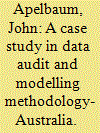

|
|
|
|
|
| Publication |
2009.
|
| Summary/Abstract |
The purpose of the paper is to outline a rigorous, spatially consistent and cost-effective transport planning tool that projects travel demand, energy and emissions for all modes associated with domestic and international transport. The planning tool (AuseTran) is a multi-modal, multi-fuel and multi-regional macroeconomic and demographic-based computational model of the Australian transport sector that overcomes some of the gaps associated with existing strategic level transport emission models. The paper also identifies a number of key data issues that need to be resolved prior to model development with particular reference to the Australian environment. The strategic model structure endogenously derives transport demand, energy and emissions by jurisdiction, vehicle type, emission type and transport service for both freight and passenger transport. Importantly, the analytical framework delineates the national transport task, energy consumed and emissions according to region, state/territory of origin and jurisdictional protocols, provides an audit mechanism for the evaluation of the methodological framework, integrates a mathematical protocol to derive time series FFC emission factors and allows for the impact of non-registered road vehicles on transport, fuel and emissions.
|
|
|
|
|
|
|
|
|
|
|
|
|
|
|
|
| 2 |
ID:
091552


|
|
|
|
|
| Publication |
2009.
|
| Summary/Abstract |
In the context of emission markets, failure to include early action (EA) as a criterion when sharing out the reduction effort may be unfair. This paper presents (1) a method based on index decomposition that seeks to quantify EA and (2) a method for determining effort sharing considering EA. It is shown that, in the case of European industry (EU-15) and for the period 1995-2005, EA accounted for a reduction of 21% in energy-related CO2 emissions. Considering two alternative schemes for sharing out the reduction effort in European industry, equal shares (all industries in all countries reduce their emissions by the same percentage) and taking EA into account, we find that Spain, Austria, Italy, the United Kingdom and Sweden would be better off under an equal shares scheme as opposed to one that takes EA into account. The efforts of the remaining countries would be greater than if EA was taken into account. An equal shares scheme would also greatly benefit the textile, non-metallic mineral, paper and "other" industries, and would be particularly detrimental to the chemical, non-ferrous and other metal, and engineering industries.
|
|
|
|
|
|
|
|
|
|
|
|
|
|
|
|
| 3 |
ID:
091702


|
|
|
|
|
| Publication |
2009.
|
| Summary/Abstract |
Electricity demand in South Africa has grown at a very rapid rate over the past decade. As part of reform initiatives to enhance long-term sustainability of the country's electricity industry, South Africa's authorities have in recent years sought to develop an electricity pricing framework that is cost reflective and forms the cornerstone of demand management schemes meant to foster changes in consumption behaviour and enhance efficiency in resource use. The effects of any pricing policy on aggregate electricity consumption will depend on a useful understanding of the factors that influence electricity demand, and the magnitude to which electricity demand responds to changes in such factors. In this context, this paper applies the bounds testing approach to cointegration within an autoregressive distributed lag framework to examine the aggregate demand for electricity in South Africa during the period 1960-2007. The results indicate that in the long run, income is the main determinant of electricity demand. With electricity prices having an insignificant effect on aggregate electricity demand, future pricing policies will need to ensure that electricity prices are cost reflective and enhance efficiency of electricity supply and use.
|
|
|
|
|
|
|
|
|
|
|
|
|
|
|
|
| 4 |
ID:
091699


|
|
|
|
|
| Publication |
2009.
|
| Summary/Abstract |
While some agent-based models have been developed for analyzing the German electricity market, there has been little research done on the emerging issue of intra-German congestion and its effects on the bidding behavior of generator agents. Yet, studies of other markets have shown that transmission grid constraints considerably affect strategic behavior in electricity markets. In this paper, the implications of transmission constraints on power markets are analyzed for the case of Germany. Market splitting is applied in the case of congestion in the grid. For this purpose, the agent-based modeling of electricity systems (AMES) market package developed by Sun and Tesfatsion is modified to fit the German context, including a detailed representation of the German high-voltage grid and its interconnections. Implications of transmission constraints on prices and social welfare are analyzed for scenarios that include strategic behavior of market participants and high wind power generation. It can be shown that strategic behavior and transmission constraints are inter-related and may pose severe problems in the future German electricity market.
|
|
|
|
|
|
|
|
|
|
|
|
|
|
|
|
| 5 |
ID:
091698
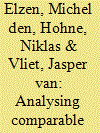

|
|
|
|
|
| Publication |
2009.
|
| Summary/Abstract |
EU Heads of State and Government agreed in March 2007 that the EU will reduce its greenhouse gas emissions to 30% below 1990 levels by 2020 within an international post-2012 climate agreement, provided that other developed (Annex I) countries commit to comparable reductions. Within this context, this paper first explores the pros and cons of many possible conceptual approaches to assess the comparability of the mitigation efforts by Annex I countries. We selected six approaches for further analysis, which represent efforts well and are technically feasible. The implications of each of these six approaches were analysed in terms of the reductions and abatement costs that must be made by different Annex I countries to meet an aggregate reduction of 20% and 30%, respectively, below 1990 levels by 2020. The analysis indicates that significant reductions are necessary for all developed countries. This study shows that reductions by the EU of at least 30%, combined with comparable reduction efforts by other developed countries to meet the aggregate Annex I reduction target of 30% by 2020 and support of developed countries for developing countries to keep their emissions 15-30% below the baseline, are sufficient to achieve the EU climate goal of 2 °C.
|
|
|
|
|
|
|
|
|
|
|
|
|
|
|
|
| 6 |
ID:
091543
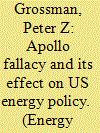

|
|
|
|
|
| Publication |
2009.
|
| Summary/Abstract |
US Policy makers have made continual references to the Apollo Program as a model for development of alternative energy technologies. This model, however, is inappropriate for energy policy, and its use is termed the Apollo fallacy. The goal of the Apollo Program was the demonstration of engineering prowess while any alternative energy technology must succeed in the marketplace. Several Apollo-like energy programs have been tried and all have failed at high cost. It is argued that the use of Apollo has political benefits but that it is detrimental to the adoption of potentially effective energy policies.
|
|
|
|
|
|
|
|
|
|
|
|
|
|
|
|
| 7 |
ID:
091547
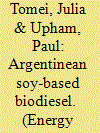

|
|
|
|
|
| Publication |
2009.
|
| Summary/Abstract |
This paper explores the economic, social and environmental context, drivers and impacts of increased demand for Argentine soy-based biodiesel. It is based on extensive stakeholder interviews in Argentina, including those in government, academia and the third sector; as well as participant observation with communities in soy cultivation areas; and review of relevant academic and grey literatures. Given Argentina's history of political instability and relatively weak levels of environmental protection, there is reason to be sceptical of the likely effectiveness of biofuel sustainability certification as applied to Argentine soy. Direct contracts between feedstock producers and biodiesel retailers may be a more reliable approach to minimise adverse environmental and social impacts than certification alone.
|
|
|
|
|
|
|
|
|
|
|
|
|
|
|
|
| 8 |
ID:
091542
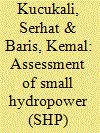

|
|
|
|
|
| Publication |
2009.
|
| Summary/Abstract |
This paper aims to evaluate the development of small hydropower (SHP) in Turkey and discusses the current situation of SHP plants in terms of government policy, economical aspects and environmental impacts taking EU policy into account. The laws published in recent years in Turkey succeeded in promoting the utilization of renewable energy for electricity generation, but it is considered that those laws are not fully compatible with EU policy. After the publication of Renewable Energy Law (Law No. 5346) there occurred a boost in SHP project along with hydropower development. Thus, the hydropower potential of Turkey increased 15% and the construction of hydropower plants also increased by a factor of four in 2007 as compared to 2006. Investment and operating costs are in favor of SHP development in Turkey as having the lowest costs among European countries (300-1000 €/kW as investment cost and 1 €cent/kWh as operating cost). Turkish governments have taken precautions for environmental issues resulted from renewable energy utilization but these are obviously not adequate. It is concluded that more attention must be paid on environmental issues and monitoring of the facilities must be enabled with further laws or regulations.
|
|
|
|
|
|
|
|
|
|
|
|
|
|
|
|
| 9 |
ID:
091526
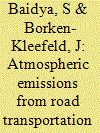

|
|
|
|
|
| Publication |
2009.
|
| Summary/Abstract |
India has become one of the biggest emitters of atmospheric pollutants from the road transportation sector globally. Here we present an up-to-date inventory of the exhaust emissions of ten species. This inventory has been calculated bottom-up from the vehicle mileage, differentiating by seven vehicle categories, four age/technology layers and three fuel types each, for the seven biggest cities as well as for the whole nation. The age composition of the rolling fleet has been carefully modelled, deducting about one quarter of vehicles still registered but actually out-of-service. The vehicle mileage is calibrated to the national fuel consumption which is essential to limit uncertainties. Sensitivity analyses reveal the primary impact of the emission factors and the secondary influence of vehicle mileage and stock composition on total emissions. Emission estimates since 1980 are reviewed and qualified. A more comprehensive inspection and maintenance is essential to limit pollutant emissions; this must properly include commercial vehicles. They are also the most important vehicle category to address when fuel consumption and CO2 emissions shall be contained.
|
|
|
|
|
|
|
|
|
|
|
|
|
|
|
|
| 10 |
ID:
091571


|
|
|
|
|
| Publication |
2009.
|
| Summary/Abstract |
Crude oil is a limited natural resource subject to depletion and several reports indicate that the world's crude oil production is close to the maximum level and that it will start to decrease after reaching this maximum. A post-Kyoto political agenda to reduce oil consumption will have the same effect on aviation fuel production as a natural decline in the crude oil production. On the other hand, it is predicted by the aviation industry that aviation traffic will keep on increasing.
|
|
|
|
|
|
|
|
|
|
|
|
|
|
|
|
| 11 |
ID:
091696
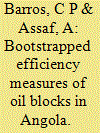

|
|
|
|
|
| Publication |
2009.
|
| Summary/Abstract |
This paper investigates the technical efficiency of Angola oil blocks over the period 2002-2007. A double bootstrap data envelopment analysis (DEA) model is adopted composed in the first stage of a DEA-variable returns to scale (VRS) model and then followed in the second stage by a bootstrapped truncated regression. Results showed that on average, the technical efficiency has fluctuated over the period of study, but deep and ultradeep oil blocks have generally maintained a consistent efficiency level. Policy implications are derived.
|
|
|
|
|
|
|
|
|
|
|
|
|
|
|
|
| 12 |
ID:
091529
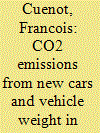

|
|
|
|
|
| Publication |
2009.
|
| Summary/Abstract |
A segment- and fuel-disaggregated analysis of the production data of the new European vehicle market during the last decade helps to understand the sharp increase in average weight, and to introduce an indicator linking CO2 emissions to a vehicle's unit of weight. Using this indicator, simulations are made to calculate the average CO2 emissions if the average weight had stayed constant from 1995 to 2005. If the weight had remained constant, the 2008 target of 1998s voluntary agreement (VA) would have been met, and the recently approved regulation would probably have been unnecessary. Then, CO2 emissions are projected to 2015 using different vehicle characteristics and market penetration. Five scenarios have been introduced to study the different opportunities that could arise by 2015, including a backcasting scenario showing what is needed to reach the goal set by the recently approved EU climate package regulations. The analysis concludes that powertrain technologies alone are unlikely to bring the sufficient break in trends to reach set targets. Acting on average weight, through unitary vehicle weight or segment shifting, of new vehicles is key in reducing the average CO2 emissions in the short and medium term.
|
|
|
|
|
|
|
|
|
|
|
|
|
|
|
|
| 13 |
ID:
091566
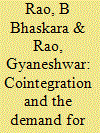

|
|
|
|
|
| Publication |
2009.
|
| Summary/Abstract |
Since the early 1970s, there has been a worldwide upsurge in the price of energy and in particular of gasoline. Therefore, demand functions for energy and its components like gasoline have received much attention. However, since confidence in the estimated demand functions is important for use in policy and forecasting, following [Amarawickrama, H.A., Hunt, L.C., 2008. Electricity demand for Sri Lanka: A time series analysis. Energy Economics 33, 724-739], this paper estimates the demand for gasoline is estimated with five alternative time series techniques with data from Fiji. Estimates with these alternative techniques are very close, and thus increase our confidence in them. We found that gasoline demand is both price and income inelastic.
|
|
|
|
|
|
|
|
|
|
|
|
|
|
|
|
| 14 |
ID:
091558


|
|
|
|
|
| Publication |
2009.
|
| Summary/Abstract |
The South African energy debate is and will remain a heated one. Given South Africa's history of racial inequality and contemporary concerns around sustainability, much of it rightly focuses on the links between energy, poverty and the environment. Yet, many contributions to the (mainstream) debate seem to have a somewhat one-sided focus that might hamper rather than stimulate the understanding of these links. They either display a strong technical, quantitative bias and/or lean towards rather simplistic ideas about policy processes and dynamics. The article argues that many of these analyses could benefit greatly from a critical focus on the political economy of energy: the political-economic power structures that influence both many energy policies and the issues of energy equality and sustainability. Two major global developments emphasise the importance of this focus: the recent financial crisis and South Africa's role in the increasingly tense geopolitics of energy in Africa. The article concludes with some suggestions on how currently disparate political economies of energy could be better connected.
|
|
|
|
|
|
|
|
|
|
|
|
|
|
|
|
| 15 |
ID:
091567
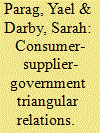

|
|
|
|
|
| Publication |
2009.
|
| Summary/Abstract |
The UK residential (household) sector is responsible for approximately 30% of total carbon dioxide emissions and is often seen as the most promising in terms of early reductions. As most direct household emissions come from only two fuel sources, this paper critically examines how existing emissions reduction policies for the sector shape - and are shaped by - relations between the three main groups of actor in this policy domain: central government, gas and electricity suppliers, and energy users. Focusing on relations between three dyads (government-suppliers, suppliers-consumers and consumers-government) enables us to examine aspects of demand reduction that have often been overlooked to date. By 'relations' we refer to services, power relationships and flows of capital and information, as well as less easily defined elements such as loyalty, trust and accountability. The paper argues that the chosen government policy path to deliver demand reduction, which heavily emphasises the suppliers' role, suffers from principal-agent problems, fails to align consumers and supplier interests toward emissions reduction, and does not yet portray a lower-carbon future in positive terms. It suggests that more attention should be paid to government-consumer relations, recognising that energy consumers are also citizens.
|
|
|
|
|
|
|
|
|
|
|
|
|
|
|
|
| 16 |
ID:
091564
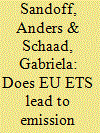

|
|
|
|
|
| Publication |
2009.
|
| Summary/Abstract |
The first trading period of the European Emissions Trading Scheme (EU ETS) has recently come to an end. The experiences of the actors in the trading sector will be of great importance in evaluating the aim and direction of this "Grand Policy Experiment". This paper gives an account of the attitudes and actions of the companies included in the Swedish emissions trading sector after about 15 months of experience with the system. The data are based on a study commissioned by the Swedish Environmental Protection Agency, and is a comprehensive survey that encompasses all companies operating installations included in the Swedish Emission Trading Registry. However, the results point in a somewhat disquieting direction. Although the Swedish companies have shown significant interest in reducing emissions, this survey indicates that this is done without close attention to the pricing mechanism of the market-based instruments. If this praxis is widespread within the European trading sector, it can have a serious negative effect on the efficiency of the system.
|
|
|
|
|
|
|
|
|
|
|
|
|
|
|
|
| 17 |
ID:
091568


|
|
|
|
|
| Publication |
2009.
|
| Summary/Abstract |
An economic assessment was conducted on five biomass-to-ethanol production pathways utilising the feedstock: wheat, triticale, sugarbeet, miscanthus and straw. The analysis includes the costs and margins for all the stakeholders along the economic chain. This analysis reveals that under current market situations in Ireland, the production of ethanol under the same tax regime as petrol makes it difficult to compete against that fuel, with tax breaks, however, it can compete against petrol. On the other hand, even under favourable tax breaks it will be difficult for indigenously produced ethanol to compete against cheaper sources of imported ethanol. Therefore, the current transport fuel market has no economic reason to consume indigenously produced ethanol made from the indigenously grown feedstock analysed at a price that reflects all the stakeholders' costs. To deliver a significant penetration of indigenous ethanol into the market would require some form of compulsory inclusion or else considerable financial supports to feedstock and ethanol producers.
|
|
|
|
|
|
|
|
|
|
|
|
|
|
|
|
| 18 |
ID:
091545
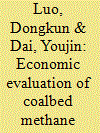

|
|
|
|
|
| Publication |
2009.
|
| Summary/Abstract |
Roaring natural gas demand, energy security and environment protection concerns coupled with stringent emission reduction requirement have made China's abundant coalbed methane (CBM) resource an increasingly valuable energy source. However, not all of China's CBM resource is economic to develop under current technological condition and economic situation. In order to locate the CBM resource with economic viability to develop in China, economic evaluation of CBM production is conducted by applying net present value (NPV) method. The results indicate that more than half of CBM resource in China is economic to develop. It shows that CBM price, production rate and operating costs are the three major factors with most impact on the economic viability of the CBM development in target areas in China. The result also demonstrates that the economic limit production is roughly 1200 cubic meters per day. These economic evaluation results provide important information for both CBM companies and China government.
|
|
|
|
|
|
|
|
|
|
|
|
|
|
|
|
| 19 |
ID:
091701


|
|
|
|
|
| Publication |
2009.
|
| Summary/Abstract |
This paper aims at developing an integrated approach for estimating the employment benefits associated with power-generation technologies. The proposed approach exploits the input-output methodology for estimating the direct, indirect and induced employment effects associated with the energy project in question, as well as two different valuation techniques, namely the "opportunity cost of labour" approach and the "public expenditures" approach, for expressing these effects in monetary terms. This framework has been implemented to estimate the employment benefits resulting from the development of a lignite-fired and a natural gas-fired power plant in Greece, taking into account all the stages of the corresponding fuel cycles that are undertaken domestically. The results of the analysis clearly show that lignite-fired electricity generation results in significant employment benefits amounting to 2.9-3.5 €/MWh in the basic scenario. On the other hand, the employment benefits associated with the examined natural gas unit were estimated at 0.4-0.6 €/MWh in the basic scenario. It is also worth mentioning that the significant environmental externalities of the lignite-fired electricity in Greece that have been presented in a number of studies can only be partially compensated by the estimated employment benefits.
|
|
|
|
|
|
|
|
|
|
|
|
|
|
|
|
| 20 |
ID:
091697
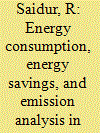

|
|
|
|
|
| Publication |
2009.
|
| Summary/Abstract |
This paper is concerned with the estimation of energy use in office buildings in Malaysia and with the energy use of major equipment. Energy intensity (EI) - a measure of a building's energy performance - is estimated for Malaysia and compared with a number of selected countries. Air conditioners are shown to be the major energy users (57%) in office buildings, followed by lighting (19%), lifts and pumps (18%) and other equipment (6%). It is estimated that 77,569 MWh of energy can be saved and a huge reduction of emissions achieved through the application of advance glazing, compact fluorescent lamps (CFL), insulation, housekeeping, and by raising thermostat set point temperature of air conditioners, and reducing EI.
|
|
|
|
|
|
|
|
|
|
|
|
|
|
|
|
|
|
|
|
|